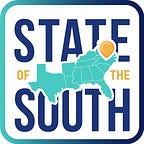Hidden Histories of the South: An Introduction
By Janay Draughn
This fall, MDC will launch “True South,” our 2022–2023 State of the South program. The program will expand upon MDC’s quantitative State of the South analysis to weave together community conversations, artistic expression, online content, and a series of reports to explore how — and if — Southerners are reckoning with this moment of economic, social, and environmental upheaval. The first topic for this year’s program is “Reclaiming Southern History & Narrative.” If we are to approach a truer South and a fuller, more beautifully quilted representation of every aspect of this region, there must be an excavation of and encounter with all Southern histories, especially those that point to the past and presence of radical imagination, transformation, and community-building in every current of the South.
The current production of history by many people and in many institutions is very limiting and limited. The current reactionary backlash that undergirds the censoring of historical, literary, and even math school materials is evidence of that. There are plenty of available, appreciated histories of wealthy, white, male, normative people, but little space is made for histories, presents, and creations that go beyond that and/or are rooted in dissent. Jesse Helms — staunch white supremacist and segregationist, opponent of MLK Day, unfair landlord, opponent of HIV/AIDS research, and five-term U.S. Senator from 1973 to 2003 — is even described as follows on a North Carolina Office of the Secretary of the State-maintained website titled “Famous North Carolinians”: “A former journalist from Monroe who became the first Republican senator elected in North Carolina in modern times. Known for his conservative viewpoints, Helms retired from the Senate after serving five terms.”
Gone unmentioned is his notorious callousness and hatefulness, such as when he sang “Dixie,” a minstrel song, next to Carol Moseley-Braun, the first Black woman in the U.S. Senate and the only non-white senator then, in an elevator in 1993 in an effort to make her cry. Gone unmentioned is his involvement in Willis Smith’s 1950 senatorial campaign, a campaign whose notoriety is demonstrated in the flyer below.
A history, however, cherry-picked and skewed, is maintained of Helms on a state website, but few Indigenous, Black, Asian, Latinx, disabled, queer, non-citizen people are included in the list of North Carolinians who are given fame. Harder to find is educational and historical material dedicated to the Battle of Hayes Pond of January 18, 1958, a night when over 500 armed and organized Lumbee men and women in Robeson County ran the KKK out of the county. The night of resistance is captured in an iconic picture below of two Lumbee community members, Charlie Warriax and Simeon Oxendine, jokingly donning a Klan flag on their backs all the way in Charlotte.
The Battle of Hayes Pond is also remembered in a boulder that sits at NC-130 and Hayes Pond, and a land marker. James “Catfish” Cole and James Martin organized the rally off the heels of years of misplaced anger from poor white workers and continued terror, from rallies to sheriff-protected caravans of Klan members that rode through the neighborhood of a Black doctor, Robert F. Williams, in Monroe. Interestingly enough, the Klan also driven away then in humiliation when 60 armed Black men, who had been protecting Robert Williams’ home for weeks, fired back at them and drove the Klan caravan away.
Hidden Histories, a series of online articles, will amplify the histories of people and communities who have built spaces and places with radical love, healing, imagination, resistance, and community in the South — like the Battle of Hayes Pond. Our South is wide and deep and joyful, just as it is haunted and pained. My hope is that we interact with these histories on our own, and eventually act on them in our imagination of and work for our communities. The stories will loosely follow the destinations where MDC will convene State of the South events throughout late 2022 and early 2023: Durham, North Carolina; Charleston, South Carolina; Berea, Kentucky; the Mississippi Delta; and back to Durham.
Each place holds its own histories and communities that, when acknowledged, can empower us to reckon with past and present conditions and behold a truer South. These histories, haunt us — knowingly or unknowingly — as we have been refused access and confrontation with them. They also offer us knowledge of what was and guidance toward what can and will be when they are conjured toward freedom. I leave us with some questions before we encounter or reencounter these hidden histories: how do we (non-Indigenous people) understand our place on colonized land, what can we learn from these voices who rise from the wreckage, and what will we do to reimagine the worlds we build in the South? Let’s learn about imaginative souls and communities who (re)built place, space, relationships, and living.
Janay Draughn is the MDC Dan Broun Summer Intern. She is from Greenville, North Carolina and is a rising junior at the University of Pennsylvania, studying English with a concentration in Africana Literature and Culture. She enjoys learning about the South and loves reading imaginative, Black Feminist, and experimental literature. She fiercely believes that orange juice is much better than apple juice. If you find any errors in this article, please contact her at medium@mdcinc.org.
